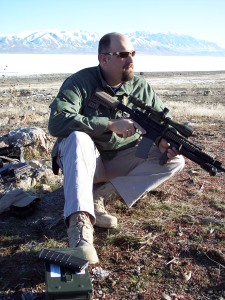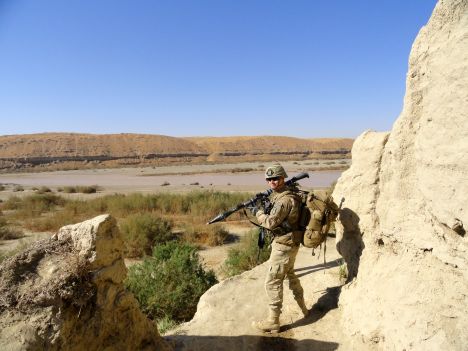Half a year of my life . . . wasted.
That was the first coherent thought that ran through my mind as Ali bin Ahmed Al Falah’s chest puckered into a grapefruit sized exit hole right in front of me. Scarlet and white bits rose like a cloud as he went to his knees, heart torn in half and still pumping…
What ever happened to the world of men’s fiction? In times past, there were whole magazines devoted to telling stories men wanted to read, entire shelves full of books at the local bookstore devoted to men’s fiction. Westerns, pulp adventure, post-apocalyptic survivalist fiction, war fiction, and books that combined all of the above could be found in any B. Dalton and Waldenbooks at the nearest mall.
But now in 2011, that’s all gone. The men’s adventure category has disappeared from the modern bookstore, scrapped to make room for “Twilight” and every other chick-lit paranormal-romance copycat that is glutting the market. And that’s okay. I don’t have anything against Stephenie Meyer and similar authors. More power to them. Anything that gets people away from the TV and gets their noses stuck in books is all right by me, but what about us guys? Don’t we deserve a section of our own in Barnes and Noble?
Yeah, we used to be exiled to the sci-fi and fantasy section, but the ladies are starting to love those genres as much as we do, thanks to Meyer and J. K. Rowling. Those of us nerds who used to hide out in the sci-fi section, silently browsing the shelves and never looking each other in the eye, suddenly find ourselves being overrun with noisy tween fangirls and their fangirl grandmothers scouring our sacred shelves for the next Edward and Bella to get obsessed with. It’s maddening, I say. There’s nowhere left for us to turn. No more really good Westerns. No More pulp. No more War section. Nada. This is an unacceptable turn of events.
Well, I, for one, am going to be a champion of the Men’s Fiction Movement, which I just made up. I declare this, here and now, for all my Big Hollywood brethren to witness. I will be the one to shine a spotlight on the kinds of books that make full grown, meat-eating, hairy American men want to slack off on the job so they can read instead; books that will make the industrious among us steal a few extra minutes reading on the forklift while the boss is in the john, or pulling over to the side of the road in the big rig and taking fifteen just to finish a chapter before they hit their next stop.
That is my job, to point out the books you might be missing out on, and hopefully the guys of Big Hollywood (any of you ladies that want to get on for the ride are welcome, too) will be entertained by the books I review.
And with that, I introduce you to “Dead Six” by Larry Correia and Mike Kupari.
“Dead Six” is a modern techno-thriller set in a world that is only slightly different than our own. Mexico has fallen to a civil war, China has broken up into two nations, and Africa, as in the real world, is still completely effed up. The action takes place in a tiny Middle Eastern nation, The Confederated Gulf Emirate of Zubara, or the Zoob, to the local expats and foreign contractors who call it home. When the characters arrive in-country, the Zoob is on the verge of a military coup and is ready to pop. Wacky hijinks ensue.
“Dead Six” has a unique schtick, differentiating itself from most novels by having two main point-of-view characters, Valentine and Lorenzo, with both character POV’s told in the first person. They are not friends.
The novel is a collaborative effort. Correia wrote one character, and Kupari wrote the other. This gives “Dead Six” a distinctive flavor all its own, as each POV character sounds like a completely different person, rather than two different characters being written by the same author.
Most techno-thrillers nowadays tend to be alike in many ways. The heroes are usually government-sponsored, jut-jawed men of action in the vein of Vince Flynn’s Mitch Rapp or Clive Cussler’s Dirk Pitt, who act on behalf of .gov to save the day against the nefarious enemies of the U.S. of A. There are also the kinds of techno-thrillers written by authors like Douglas Preston and Lincoln Child which feature jut-jawed Men of Science saving the day against the insane CEO of whatever megalomaniacal, high-tech corporation the writers came up with to threaten the world. Not that I have a problem with any of these books, but I’ve read them all before. Now I want something a little different.
“Dead Six” is different.
For one thing, instead of the jut-jawed, chiseled government heroes of most thrillers, you have a young, nerdy, burnt-out mercenary and a runty thief-slash-con-man fighting against terrorists, crime lords, and each other, in the middle of a city-state on the brink of civil war. And it’s awesome.
The secondary characters are all great as well. The heroes’ compatriots are fleshed out, engaging people that you grow to care about. The villains in “Dead Six” are the kinds of villains you find in real life, rather than in the pages of a James Bond novel. These are the kind of bad guys who won’t leave you to die in a pit of crocodiles while they and their henchman go off to creepily menace the scantily-clad heroine. Nope, these black hats will just drag you into an abandoned warehouse, saw your head off with a rusty bayonet for Al-Jazeera and be done with it; and the girl is not your problem anymore.
“Dead Six” is a pretty violent book. It’s about war and terrorists. Murderers, assassins, and torturers abound. The action is visceral and bloody without being overly graphic for you squeamish tenderfeet. Well, maybe a little graphic. Correia and Kupari know their business and portray the firefights and violent scenes in this book realistically. Both authors know their weapons, too. You won’t find any automatic revolvers or Glocks with cocking hammers in this book. The firearms and action scenes are authentic and well-researched. As a bitterly-clinging gun nut, I can appreciate that.
Action, excitement, ambushes, and desperate battles, with a little romance, conspiracy, and betrayal added for flavor — “Dead Six” has it all.
It’s not without its humor, either, especially for us red state plebes in flyover country. “Wow, you really kicked Michael Moore’s ass,” a character tells one protagonist after a fight with a large “slug of a man.” The narrator dryly recalls, “It had kind of looked like him… Naw.”

Correia is best known for his New York Times bestselling “Monster Hunter International” series. His new series, “The Grimnoir Chronicles,” began this year with “Hard Magic” and “Spellbound.” “Dead Six” is the first book in a trilogy, but it also stands alone.
Correia’s is a hell of a nice guy; a family man, an accountant, former machinegun dealer, competitive shooter, and a great blogger. It’s always a treat when one of his snarky political rants gets linked to Instapundit and a thousand liberals’ heads explode out of sheer outrage. You can find his blog here.

Kupari is an ex-Army National Guardsman, a former private military contractor, a hand-numbed wielder of .44 magnums, and is currently defusing roadside bombs in Afghanistan serving as an Air Force explosive ordnance disposal technician. Yeah, he’s one of those badass Hurt Locker guys, only without the death wish and the homoerotic wrestling. He’s also a nice guy, and he’s missed the release of his first book to serve his country doing one of the riskiest jobs in the military in one of the worst hellholes of the Middle East. Watch your back, Kupari, and send in the robot first.
You can find “Dead Six” on Amazon, or you can order the DRM-free e-book in any format you want, directly from the publisher, Baen Books, for only six bucks.
And just like crack dealers, Correia and Kupari have given away two prologue chapters of “Dead Six” which wound up on the cutting room floor, free of charge and for your enjoyment, just to get you hooked.

COMMENTS
Please let us know if you're having issues with commenting.